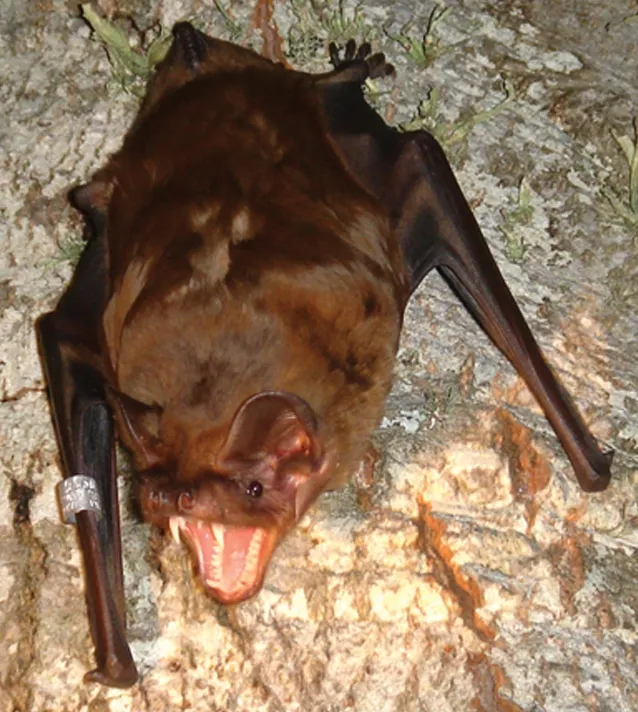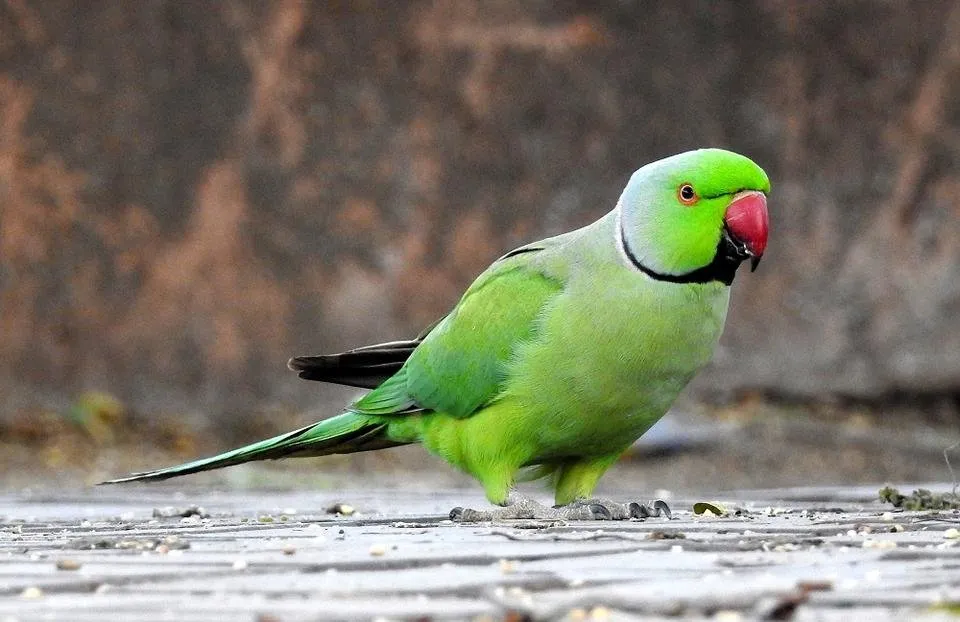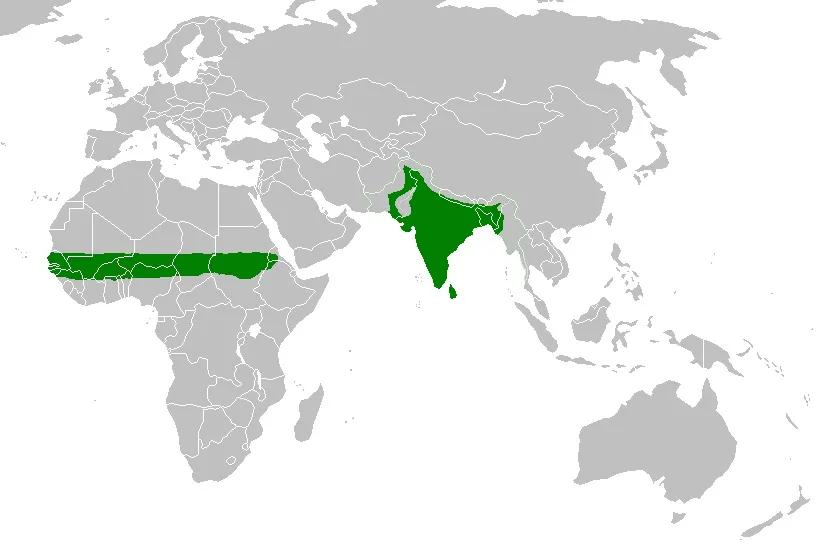The greater noctule bat (Nyctalus lasiopterus) is the largest species of bat we have in Europe, with a wingspan that can be as long as 46cm. They are pretty rare, and have been classified as Vulnerable by the IUCN Red List. This basically means that they are not in any immediate threat of extinction, but they are definitely heading towards this point unless we take measures to protect them.

A greater noctule bat. Image by Nicolharper at English Wikipedia, posted with the Creative Commons Attribution 2.5 Generic license.
In its natural setting, the greater noctule bats hunt and eat birds, and they are in fact the only bat that is capable of hunting birds while they are in flight. All other bat species who kill birds do so when the birds roosts, so it’s a pretty unique species. It is of course not able to kill and eat bigger birds, and in fact it seems like the exact opposite has happened at María Luisa Park in Seville, Spain.
How the greater noctules ended up being hunted by parakeets
The greater noctule bats have been living in hollow trees in María Luisa Park for a long time. They have been doing fine there despite the species declining in total, and they have had a good supply of both food and shelter. It might sound strange to have a population of bats in the middle of a park, but it is in fact one of the biggest breeding populations in all of Europe, so it’s a very important population for the species as a whole.
A few years ago people in the area started to notice that some bats were found dead with torn wings, and they even found corpses of nursing pups who generally don’t leave their shelter. More bats were found injured with wings that were badly harmed, rendering them unable to fly or even crawl back to their nests.
This phenomena brought the curiosity of a group of scientists from Estación Biológica de Doñana in Seville, and they began to investigate who could be behind the attack. No one has previously seen this type of attack on a greater noctule before, so it was a big mystery. After some investigation, the team quickly learned that is was rose-ringed parakeets (Psittacula krameri) who were behind the attacks, and even witnesses a few attacks.

A male rose-ringed parakeet. Image by Dr. Raju Kasambe, posted with the Creative Commons Attribution-Share Alike 4.0 International license.
But why are rose-ringed parakeets even in Spain?
Rose-ringed parakeets do have a huge range, and they are found in both Africa where they live close to the equator, and in some countries around India in Asia, including Pakistan, Myanmar and Bangladesh. But as you can see from the map below, they are not really found anywhere close to Spain at all.

The range of rose-ringed parakeets. Image is Public Domain.
The reason behind why they are found in María Luisa Park lies in the fact that they are very popular to keep as pets. They are a good species of parrot to keep if you are into that type of pet animals, but the fact that they are able to thrive in a huge range naturally also means that they are highly adaptable when it comes to surviving in new areas.
When a research team surveyed the amounts of feral rose-ringed parakeets in Europe, they found out that there was over 85,000 wild individuals in 10 different European countries, including countries such as Germany, Belgium and the UK. The same study concludes that the rose-ringed parakeet is the most invasive species of bird in all of Europe, and that is exactly what happened in María Luisa Park in Spain.
Apparently 10 birds were confiscated and released back in the 1990s, but at that time no one expected them to be a problem. However, they began to reproduce, and by now they are estimated to be a population with several thousand members.
As the numbers of parakeets grew, they needed more places to nest, and just like the greater noctules, they also really enjoy to make nests in the hollow trees in the park.

Baby birds who poke out of the tree. Image by Sarthak Shah, posted with the Creative Commons Attribution-Share Alike 3.0 Unported license.
As all the trees became occupied in the park, the parakeets needed to get rid of the trees the bats were using, and it turns out that they were fully capable of injuring and killing the bats, and steal their nests.
Can we save the greater noctule bats?
At this point it is believed to only be around 250 bats left in the park, so they are not in a good spot at all. The number of occupants per tree has also doubled compared to pre-invasion of parakeet levels.
The researchers behind the study believes that they only way they can save the population in the park is by eradicating the parakeets, and back in 2016 the city government decided to take action towards this. However, just before the plans were about to go into action, they backed out because of fear of what the public would think. Apparently more people prefer to have an invasive (but cute) parrot in the park instead of a rare species of bat that is threatened with extinction.
Some people have suggested putting out artificial “bat boxes” where the bats can create nests, but the greater noctules don’t really like these as much as other species of bats do. It seems like getting rid of, or severely reducing the rose-ringed parakeet population is the only solution, but unfortunately it seems impossible to do this when the public opposes it.
This mean that the greater noctule bats are heading for a rather uncertain future, and unless someone steps up and convinces the government to take action, more and more bats will be mutilated and killed by the aggressive parrots.
Thanks for reading
This is not the nicest story to read since it has a pretty bad ending, but thanks for reading it anyway. I hope you enjoyed learning more about the interactions between the greater noctules and the rose-ringed parakeets in this park in Spain, and don’t forget to leave a comment below if you got anything on your mind!
About @valth
Hey, I'm @valth - the author of this post. I love to write about nature, biology, animals, nature conservation, ecology and other related branches of science, and I occasionally write about my life, about Steem or about random stuff as well. I'm trying my best to write at least one post every day, so make sure to give me a follow if you enjoy my content and want to see more of it.
Join the @valth community!
I love nothing more than to engage with my readers, so please join the @valth community in the comment section. You will definitely find more information about the topic, personal experiences, questions, and even opposing views down there, so don't miss out on learning more.
I always reward users who post good comments, so please take the opportunity to share your views and get a small upvote in exchange for it.